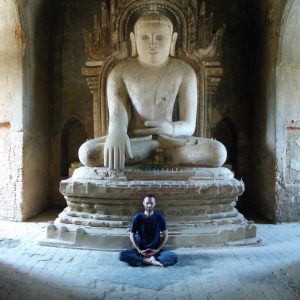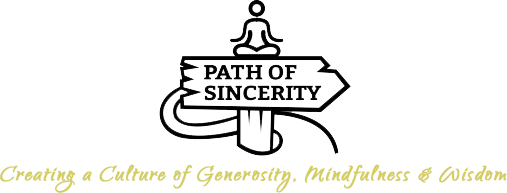
This reflection originally appeared in the newsletter from July 27th, 2022.
How I Practice Meditation
When someone asks me what type of meditation I practice, I usually say “Insight Meditation,” to which they often respond something like, “what does that mean?” or “so you do [XYZ] technique?”
These are the questions I wish to speak to today.
However, as a backdrop, during my two years in Myanmar, my Insight Meditation (aka Vipassana) teacher, Sayadaw U Tejaniya, didn’t really advocate for any particular meditation “technique.” It wasn’t that important to him if we did open awareness, mindfulness of breathing, body scanning, or anything else. Instead, he was more interested in teaching an ”approach” to meditation.
More specifically, his approach involved these three tasks:
- Being aware, especially developing a relaxed natural awareness that works during “formal meditation,” but also throughout the course of our daily lives. He didn’t want us to be dependent on just one technique, and encouraged using any number of tools or methods to help us be present in different situations. However, he especially emphasized being aware of our minds, as that’s the true realm of our happiness or suffering.
- Applying wise effort. Primarily, he instructed us to tend to our minds all day long — to keep going. Not with some rigid or intense discipline, but with a gentle perseverance. To deeply prioritize being aware, to letting go of reactivity, and to applying ourselves for good.
- Having wise view. To see meditation as a process not of getting particular results, like making difficult emotions go away or always feeling focused & calm, but rather seeing it as a process of being-with whatever is present and deepening our understanding of it, especially on the ultimate level (more on this below).
While this approach may be a bit more complex than “focus your attention on the breath at your nostrils,” it develops over time and becomes engrained like any skill. For example, an athlete may spend countless hours practicing many different aspects of their sport, but it’s all to end of making those many little skills intuitive, so on the gameday of their lives, they naturally flow out of them.
More on Wise View
In traditional jargon, what it means to understand reality on the ultimate level is to perceive how everything we can possibly notice — thoughts, sensations, emotions, sounds, etc. — is constantly changing, is not who you are, and leads to suffering if you resist or crave it.
In my language, it means we start every experience from the vantage point of “here we are.” Sitting here at this table, writing this newsletter, sounds in the background, sensations buzzing in my body. Here I am. Relaxing into this moment.
Sitting here at this table, I rest in a simple relaxed awareness and notice with the “wisdom lens” that I am not my feelings, sensations, thoughts, or emotions. None of those things happen because I will them to, but rather due to a long process of cause and effect. It’s like how an oak tree drops its leaves only when the time is ripe. It’s impersonal. Nature at work.
When I’m in a difficult conversation, I know on a deep level that who I am is not the reactive impulses that arise or the feelings of tension in my chest. When I drop deep into meditation and experience great tranquility, I likewise see with awareness+wisdom that this is just a delightful but fleeting state, and can be with it without grasping. These things are all happening in accordance with nature.
Instead of being any of those things (or trying to figure anything out), I take refuge in awareness. I be aware. I notice how anything I experience or perceive in the present comes and goes. All of those natural events — sensations, thoughts, emotions, etc. — are just “happenings in awareness,” like the contents of a movie are simply happenings on your TV monitor. From this place, I let nature do its work and observe that if I resist those things or pine away for greener pastures, I experience tension.
Wise view more simply put: it’s all nature.
As the years of meditation practice pile on top of each other, this “wise view” becomes as natural as a pianist playing without looking at their fingers.
However, along the way, it’s helpful to remind ourselves of the wise view, especially when we’re getting reactive! It’s also helpful to log many hours of formal meditation — where we train ourselves in how to be aware, how to apply ourselves, and how to see more clearly.
This wisdom lens is basically a way of inhabiting the present moment that leads to deep inner peace, contentment, and ease. It doesn’t mean we’re aloof to the world, but rather we aren’t so caught up in our reactivity, fears, projections and angers, and, then, are able to act in our lives with great discernment and heart.
U Tejaniya-style Techniques
While it’s great to take on an approach that teaches us how to be aware, gently perseverant, and to see situations with wisdom, it’s also important to have the how-to. Without methods of actually being & stabilizing awareness, all of this is nothing more than good ideas.
I’ve personally found it helpful to have a few specific techniques that help me calm my mind when I’m more scattered and distracted — historically, I’ve rather liked the body scan for this, but sometimes deep breathing, mantra, noting, or any number of other techniques have helped. Other people like completely different methods; there is no cookie method that works for everyone, and, instead, this approach empowers us to find the ones that work for us personally.
Beyond being able to bring the mind to a place of calm & settledness, U Tejaniya quite often pointed people towards a more relaxed, open awareness. Sometimes he called the practice “wait and watch.” As in, we just rest in awareness and then observe reactions happen, how we grab hold of things/nature as “me or mine,” how we crave or resist certain experiences. He said that it was through this observing in-real-time that wisdom develops & we learn how to not get entangled in those things. Once again, the direction of all this is a deep sense of ease in one’s own skin.
Conclusion
When people ask me what I mean by Insight Meditation, it’s all of the above, perhaps with a few threads of loving-kindness & joy added in. I practice awareness in such a way that I’m able to show up without reactivity, and with presence and clarity in my life.
I’ve found this particular “approach” very helpful, as it basically offers us a way of being in any given situation, pleasant or unpleasant, with full presence & clarity.
If you’d like to learn more, consider reading Sayadaw’s excellent book, “Relax & Be Aware,” as it breaks all this down much more eloquently than I have above. And for those of you who are local, this is the practice I will be teaching in the upcoming 8-week course below!
—————
If you would like to get a monthly’ish email with reflections like this one, along with some event updates, sign up here for the newsletter.
